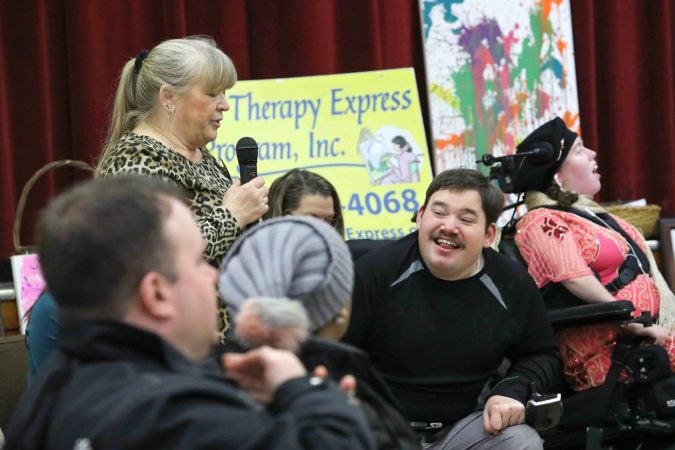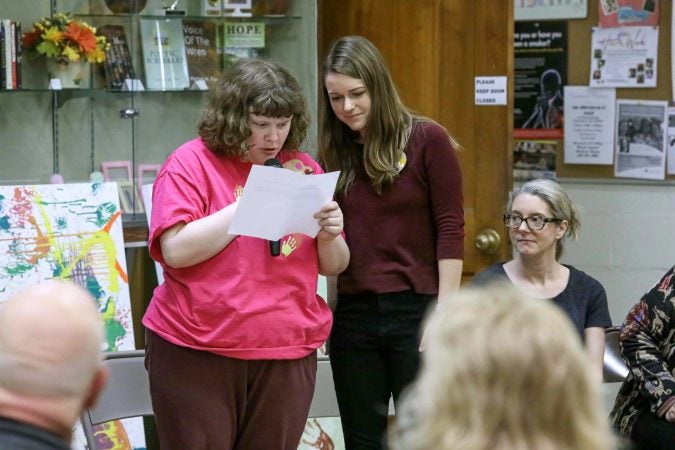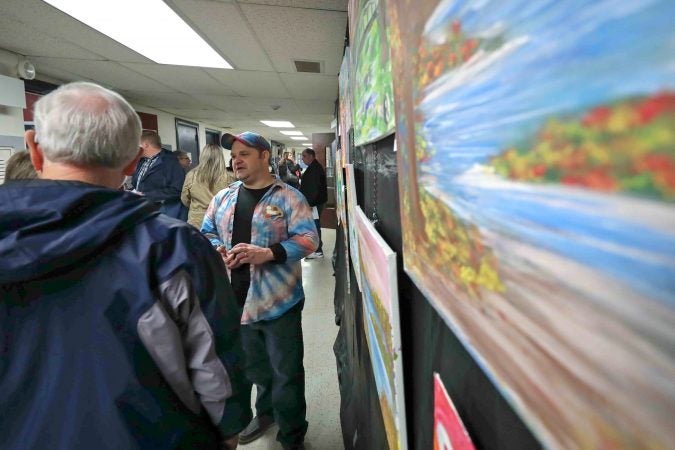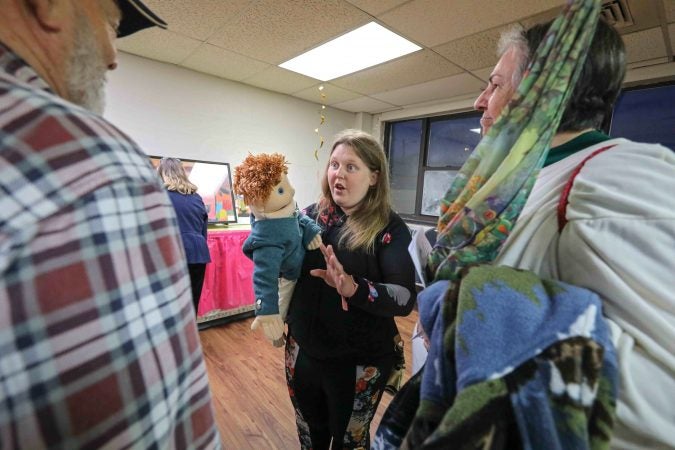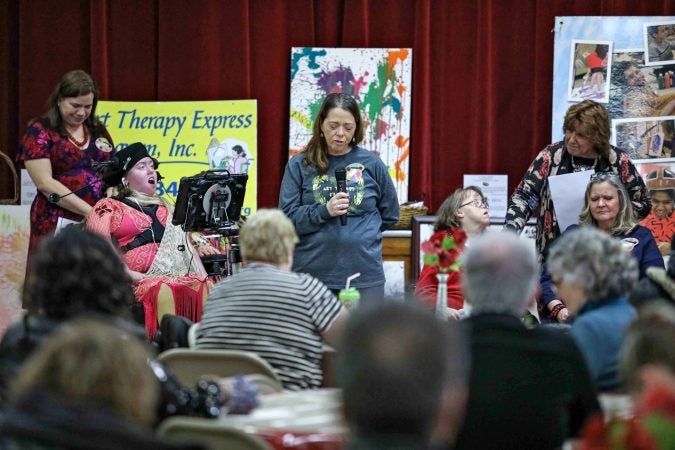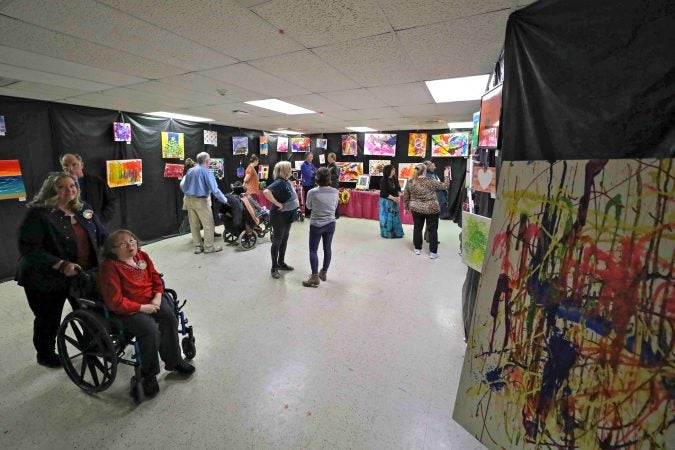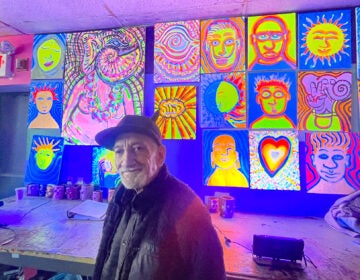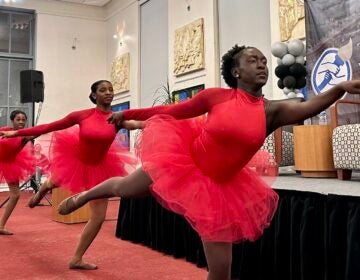At Del. exhibit, art therapy provides expressive outlet, solace to people with disabilities
Art Therapy Express presented an exhibition Monday. The award-winning Delaware program helps artists with disabilities express themselves.
Listen 2:00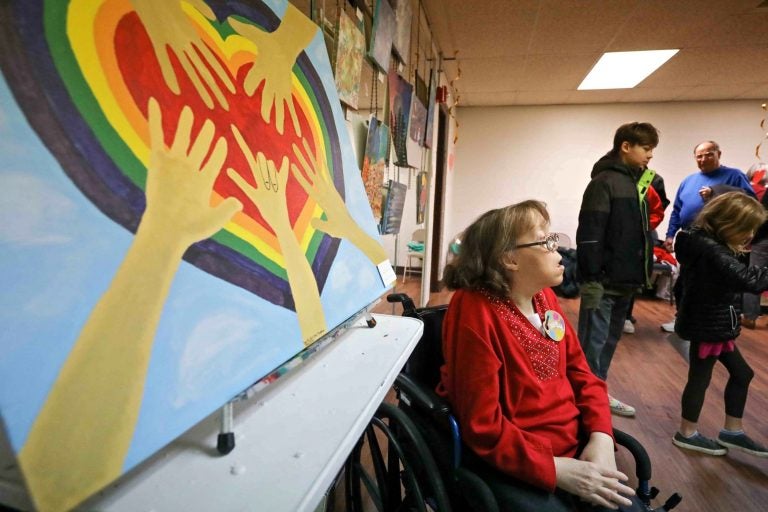
Artist Danielle Fangman is seen near her painting, 'Family Love,' during an art therapy exhibit on Feb. 10, 2020, at The Art Studio in Wilmington, Del. (Saquan Stimpson for WHYY)
David Turner found a path from darkness to light through art therapy.
Over the last seven years, he’s painted hundreds of landscapes, portraits and abstracts that chronicle his difficult journey with bipolar disorder. His healing began when he attended a session with the nonprofit Art Therapy Express.
“It was a very dark time in my life when I started here,’’ the 44-year-old Turner said. “I needed to do something to change the person I was. I hated myself. I wanted to kill myself every single day. That’s all I thought about.”
Turner spoke with WHYY on Monday night as he joined several fellow artists with disabilities during an exhibit at the Art Therapy Express studios in Belvedere, about five miles south of Wilmington.
Painting helps Turner feel alive and brings him solace.
“To me, it’s very freeing,’’ he said. “I paint with my fingers a lot. It allows me to go to a peaceful place in my mind and paint it on canvas. A lot of times, I deal with struggle with emotions and sadness and anger and anxiety and depression and all these things. While I’m here at the studio, while I’m painting, that all goes away.”
Lisa Bartoli created Art Therapy Express. She has cultivated a host of volunteers, including college students and the artist themselves. Last year, the program won the Delaware 2019 Governor’s Award for the Arts for community engagement.
The program operates in schools, hospitals and community centers for people with intellectual, physical, emotional and communication-related disabilities.
“We have people with cerebral palsy,’’ Bartoli said. “We have people who have experienced a stroke, individuals with visual and hearing impairments. We have people with Down syndrome. We have people with autism. The whole gamut.”
“People with disabilities may find it difficult to express themselves verbally, so I think we give them a tool to express themselves and connect with their peers” in an inclusive setting, she added.
Haley Shiber has cerebral palsy. She cannot speak or use her hands. But she paints bright canvases using a brush attached to her head or a robotic device attached to her arm.
She cannot use her own vocal cords to speak, but uses an augmentative communication device attached to her wheelchair to speak for her.
For Monday’s event, this lover of all things Parisian wore a beret and pre-recorded a greeting for visitors.
“When I create art, I feel determined, motivated and inspired,’’ the 23 year old said. “In the art studio, I use adaptive splints and paintbrushes to create my canvases. Art makes me happy and I look forward to it. I heart art.”
Another artist featured Monday was Lora Divorski. The 35-year-old woman with an intellectual disability showed off her cherished painting of Peppa Pig and collages of amorphous animals made with construction paper, cloth and marker.
“I very much enjoy doing art,’’ Divorski said. “I like to do different media and mixed media, like mixing different things.”
“This one kind of has hair and ears and eyes and claws,’’ she said while showing off one of the collages.
Divorski is also a bit of an entertainer. She clutched a big stuffed bunny, which she uses for her deep-voiced ventriloquism.
“It’s not a toy. It’s a way to sort of express my art,’’ she tells a visitor before breaking into character: “Hello, there. Hey, you look gorgeous today!”
Divorski also volunteers to help other artists, says her mother, Nancy Staisey.
“It means a lot in terms of self-worth and self-value to her for her to be able to help others too, especially when she’s able to help them accomplish something that she finds so rewarding,” Staisey said.
Another volunteer, Lejan Castro, is a recent college graduate who now serves on the board of directors.
“If you look around, you can see a lot of art participants who don’t have as much motor control,” Castro said.
Castro added that the devices that help them use a paintbrush “allow them to do art independently, which does a lot for them, because usually they need a lot of support and this is a way for them to do something on their own and express themselves.”
WHYY is your source for fact-based, in-depth journalism and information. As a nonprofit organization, we rely on financial support from readers like you. Please give today.



